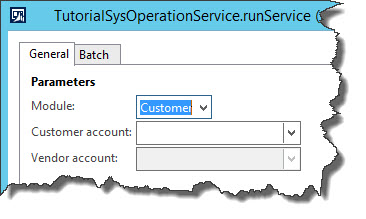Dynamics AX Blog - sysoperation-framework - Posts from 2017
SysOperation-Framework: Change the properties of a dialog box depending on other dialog boxesConsider the following scenario: In the dialog of a SysOperation construct, a field must be manipulated depending on other fields, for example, the AllowEdit property should be changed.
In the following you will find the code for a DataContract and the corresponding UIBuilder, in which the corresponding program logic is to be installed. Here, depending on the selection in the Module field, you can either activate the Customer account field or the Vendor account field.
DataContract
[DataContractAttribute, SysOperationContractProcessingAttribute(classStr(TutorialSysOperationUIBuilder))]
public class TutorialSysOperationDataContract
{
ModuleCustVend moduleCustVend;
CustAccount custAccount;
VendAccount vendAccount;
}
[DataMemberAttribute, SysOperationControlVisibilityAttribute(true), SysOperationDisplayOrderAttribute('1')]
public ModuleCustVend parmModuleCustVend(ModuleCustVend _moduleCustVend = moduleCustVend)
{
moduleCustVend = _moduleCustVend;
return moduleCustVend;
}
[DataMemberAttribute, SysOperationControlVisibilityAttribute(true), SysOperationDisplayOrderAttribute('2')]
public CustAccount parmCustAccount(CustAccount _custAccount = custAccount)
{
custAccount = _custAccount;
return custAccount;
}
[DataMemberAttribute, SysOperationControlVisibilityAttribute(true), SysOperationDisplayOrderAttribute('3')]
public VendAccount parmVendAccount(VendAccount _vendAccount = vendAccount)
{
vendAccount = _vendAccount;
return vendAccount;
}
UIBuilder
public class TutorialSysOperationUIBuilder extends SysOperationAutomaticUIBuilder
{
DialogField df_ModuleCustVend;
DialogField df_CustAccount;
DialogField df_VendAccount;
}
The methods generated by the framework are made accessible in the method build(). This is the first time the modifyDialogFields() method is called, so that the property of the desired field is changed immediately, when the dialog is opened.
public void build()
{
super();
df_ModuleCustVend = this.bindInfo().getDialogField(this.dataContractObject(), methodStr(TutorialSysOperationDataContract, parmModuleCustVend));
df_CustAccount = this.bindInfo().getDialogField(this.dataContractObject(), methodStr(TutorialSysOperationDataContract, parmCustAccount));
df_VendAccount = this.bindInfo().getDialogField(this.dataContractObject(), methodStr(TutorialSysOperationDataContract, parmVendAccount));
this.modifyDialogFields();
}
In the postRun() method, the modify() method of the module field is overridden.
public void postRun()
{
super();
// Override modified method
df_ModuleCustVend.registerOverrideMethod(methodStr(FormComboBoxControl, modified),
methodStr(TutorialSysOperationUIBuilder, moduleCustVend_modified),
this);
}
In this overridden method, we call the modifyDialogFields() method. Here, it is important that the method obtain the correct parameter profile and return the expected AX data type.
private boolean moduleCustVend_modified(FormComboBoxControl _control)
{
this.modifyDialogFields();
return _control.modified();
}
The "magic" goes through the modifyDialogFields() method. The fields are enabled or disabled, depending on the value selected in the module field.
private void modifyDialogFields()
{
df_CustAccount.allowEdit(df_ModuleCustVend.value() == ModuleCustVend::Cust);
df_VendAccount.allowEdit(df_ModuleCustVend.value() == ModuleCustVend::Vend);
}
Of course, many other properties of dialog boxes can be changed dynamically in the same way. |
SysOperation Framework: Simple class construct with data providerThe code below is a simple class construct for the SysOperation framework. Datacontract
[DataContractAttribute]
public class TutorialSysOperationDataContract
{
CustAccount custAccount;
}
[DataMemberAttribute]
public CustAccount parmCustAccount(CustAccount _custAccount = custAccount)
{
custAccount = _custAccount;
return custAccount;
}
Service
class TutorialSysOperationService extends SysOperationServiceBase
{
}
The method runService() is the actual service method. Using the SysEntryPointAttribute attribute, we control here that no further authorization checks are necessary.
[SysEntryPointAttribute(false)]
public void runService(TutorialSysOperationDataContract _dataContract)
{
info("Done");
}
|
SysOperation-Framework: Simple class constructThe following code shows a very simple class construct for the SysOperation framework. Without the Dataprovider and UIBuilder. Service
class TutorialSysOperationService extends SysOperationServiceBase
{
}
The method runService() is the actual service method. By means of the attribute SysEntryPointAttribute we control here that no further authorization checks are necessary.
[SysEntryPointAttribute(false)]
public void runService()
{
info("Done");
}
Controller
class TutorialSysOperationController extends SysOperationServiceController
{
}
In the new()-method, we link the controller to the service class.
void new()
{
super();
this.parmClassName(classStr(TutorialSysOperationService));
this.parmMethodName(methodStr(TutorialSysOperationService, runService));
}
The main()-method is the classic entry point when the controller is called via a MenuItem.
public static void main(Args _args)
{
TutorialSysOperationController controller;
controller = new TutorialSysOperationController();
controller.parmArgs(_args);
controller.parmExecutionMode(SysOperationExecutionMode::Synchronous);
controller.startOperation();
} |
|
|
|
|
|
|



If you have to lock a dialog field within a SysOperation-framework, which is integrated via a parm method, you can use code like the following (in UIBuilder).
public void postBuild() { DialogField df_SalesId; super(); df_salesId = this.bindInfo().getDialogField( this.dataContractObject(), methodStr(DEV_SalesUpdateDatacontract, parmSalesId)); if(df_salesId) { df_salesId.allowEdit(false); df_salesId.skip(true); } }